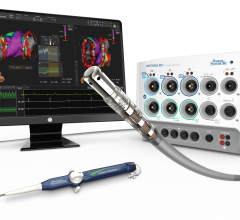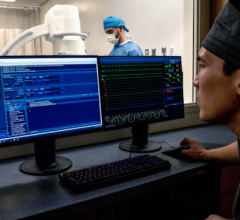Heart Rhythm Society (HRS) President-Elect Hugh Calkins, M.D., FACC, director, cardiac arrhythmia services and EP lab ...

A new electromapping technique can better visualize the rotor (similar to the eye of a hurricane) around which atrial fibrillation electrical activity rotates. Using this map, the electrophysiologist can position an ablation catheter on the rotor center and see immediately results of the treatment. By using this targeted technique, in some cases a single ablation can terminate the AFib.
Pivitol trial data regarding the safety and efficacy of the Cameron Health Subcutaneous Implantable Cardioverter ...
Providing exceptional cardiovascular care for patients to achieve the best possible outcomes is the number one goal for ...
Implantable cardioverter defibrillators (ICDs) are safe in patients who participate in sports, according to a study ...
May 16, 2012 — Steinberg Diagnostic Medical Imaging Center (SDMI) in Las Vegas has installed the first Aquilion Prime 160 series from Toshiba America Medical Systems Inc. in the United States.
May 16, 2012 — Maquet Cardiovascular LLC announced this week that it has received 510(k) clearance from the U.S. Food and Drug Administration (FDA) for its new Mega 7.5 Fr. 30 cc and 40 cc intra-aortic balloon (IAB) catheters. The larger volume catheters will allow clinicians to provide patients with greater hemodynamic support, regardless of their height.
Cardiac positron emission tomography (PET) is growing in popularity among cardiologists because it provides the ability ...
New data from the PARTNER trial for the Edwards Sapien Valve were presented during the American College of Cardiology ...
The ACRIN-PA trial showed computed tomography (CT) coronary angiography can be more cost-effective than the standard-of ...
May 15, 2012 — A robotic system can safely assist interventional cardiologists in performing percutaneous coronary interventions (PCI) while significantly reducing the physician's exposure to radiation and improving precision and control, according to results of the PRECISE study (CorPath Percutaneous Robotically-Enhance Coronary Intervention Study), presented as a late-breaking clinical trial at the Society for Cardiovascular Angiography and Interventions (SCAI) 2012 Scientific Sessions on May 10.
When performing radiofrequency (RF) ablation to treat cardiac arrhythmia, medical professionals must balance the safety ...
May 15, 2012 — A hybrid technique that combines coronary stenting with minimally invasive, robotically assisted bypass surgery both reduces the risk of surgical complications and speeds recovery in patients with multiple blockages of the coronary arteries, according to a study presented at the Society for Cardiovascular Angiography and Interventions (SCAI) 2012 Scientific Sessions on May 10.

The National Heart, Lung and Blood Institute (NHLBI), a division of the National Institutes of Health (NIH), recently awarded a $2.5 million grant to Mayo Clinic’s Cardiorenal Research Laboratory to see if snake venom can improve outcomes of heart attack and heart failure patients.
Cardiology physician groups and institutions are increasingly being challenged to effectively manage their ambulatory electrocardiography (AECG) and cardiovascular implantable electronic device (CIED) service lines, while the amount of data produced and the requirement for electronic medical record (EMR) integration increases, and reimbursement for the services declines.
Change Healthcare Cardiology Hemodynamics is an integrated hemodynamic monitoring system for monitoring vital signs and ...
May 15, 2012 — A simple clinical assessment performed in the doctor’s office can identify patients who are at high risk for stroke and other major complications following a procedure to clear blockages from the neck arteries that supply blood to the brain, according to a study presented at the SCAI 2012 Scientific Sessions.
May 15, 2012 — In a keynote Founders’ Lecture at the Society for Cardiovascular Angiography and Interventions (SCAI) 2012 Scientific Session on May 10, Ted Feldman, M.D., FSCAI, highlighted how percutaneous valve therapies may soon be the accepted treatment for a wide range of patients.

Single photon emission computed tomography (SPECT) remains a well-entrenched imaging modality for nuclear myocardial perfusion imaging (MPI) more than 30 years after its introduction. Due to SPECT’s reliability, cost-effectiveness and the wealth of data showing its clinical validation, it remains more common in MPI than its competition, positron emission tomography (PET).


 May 17, 2012
May 17, 2012












